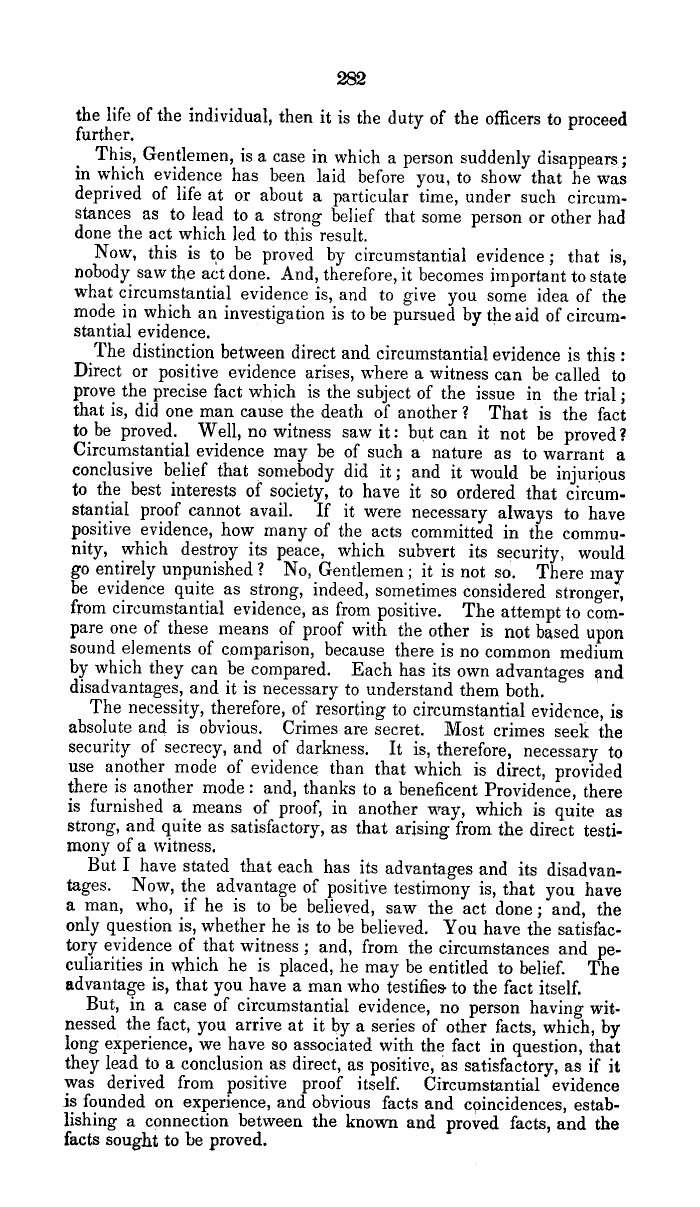|
282
the life of the individual, then it is the duty of the officers to proceed
further.
This, Gentlemen, is a case in which a person suddenly disappears;
in which evidence has been laid before you, to show that he was
deprived of life at or about a particular time, under such circum-
stances as to lead to a strong belief that some person or other had
done the act which led to this result.
Now, this is to be proved by circumstantial evidence ; that is,
nobody saw the act done. And, therefore, it becomes important to state
what circumstantial evidence is, and to give you some idea of the
mode in which an investigation is to be pursued by the aid of circum-
stantial evidence.
The distinction between direct and circumstantial evidence is this
Direct or positive evidence arises, where a witness can be called to
prove the precise fact which is the subject of the issue in the trial;
that is, did one man cause the death of another ? That is the fact
to be proved. Well, no witness saw it: but can it not be proved?
Circumstantial evidence may be of such a nature as to warrant a
conclusive belief that somebody did it; and it would be injurious
to the best interests of society, to have it so ordered that circum-
stantial proof cannot avail. If it were necessary always to have
positive evidence, how many of the acts committed in the commu-
nity, which destroy its peace, which subvert its security, would
go entirely unpunished? No, Gentlemen; it is not so. There may
be evidence quite as strong, indeed, sometimes considered stronger,
from circumstantial evidence, as from positive. The attempt to com-
pare one of these means of proof with the other is not based upon
sound elements of comparison, because there is no common medium
by which they can be compared. Each has its own advantages and
disadvantages, and it is necessary to understand them both.
The necessity, therefore, of resorting to circumstantial evidence, is
absolute and is obvious. Crimes are secret. Most crimes seek the
security of secrecy, and of darkness. It is, therefore, necessary to
use another mode of evidence than that which is direct, provided
there is another mode : and, thanks to a beneficent Providence, there
is furnished a means of proof, in another way, which is quite as
strong, and quite as satisfactory, as that arising from the direct testi-
mony of a witness.
But I have stated that each has its advantages and its disadvan-
tages. Now, the advantage of positive testimony is, that you have
a man, who, if he is to be believed, saw the act done; and, the
only question is, whether he is to be believed. You have the satisfac-
tory evidence of that witness ; and, from the circumstances and pe-
culiarities in which he is placed, he may be entitled to belief. The
advantage is, that you have a man who testifies to the fact itself.
But, in a case of circumstantial evidence, no person having wit-
nessed the fact, you arrive at it by a series of other facts, which, by
long experience, we have so associated with the fact in question, that
they lead to a conclusion as direct, as positive, as satisfactory, as if it
was derived from positive proof itself. Circumstantial evidence
is founded on experience, and obvious facts and coincidences, estab-
lishing a connection between the known and proved facts, and the
facts sought to be proved.
|

